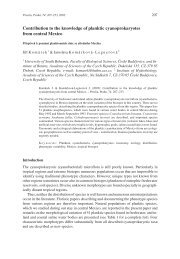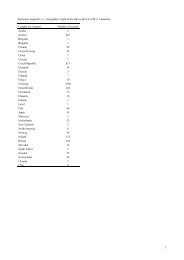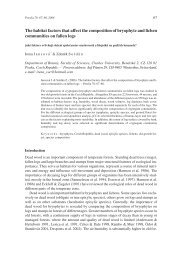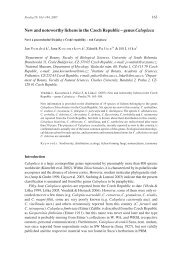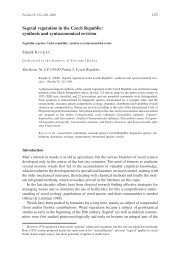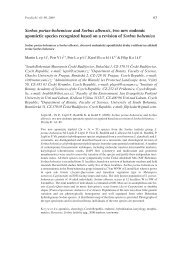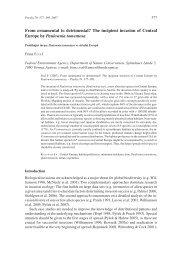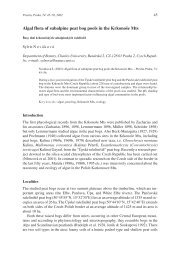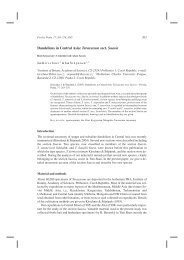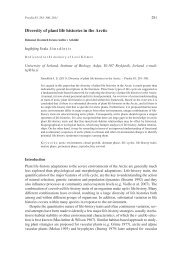Phytosociological and floristic evaluation of a 15-year ecological ...
Phytosociological and floristic evaluation of a 15-year ecological ...
Phytosociological and floristic evaluation of a 15-year ecological ...
Create successful ePaper yourself
Turn your PDF publications into a flip-book with our unique Google optimized e-Paper software.
Preslia, Praha, 74: 421–436, 2002 421<br />
<strong>Phytosociological</strong> <strong>and</strong> <strong>floristic</strong> <strong>evaluation</strong> <strong>of</strong> a <strong>15</strong>-<strong>year</strong><br />
<strong>ecological</strong> management <strong>of</strong> roadside verges in the Netherl<strong>and</strong>s<br />
Fytocenologické a <strong>floristic</strong>ké změny ve vegetaci silničních okrajů v Nizozemsku v průběhu <strong>15</strong> let<br />
Karel V. S ý k o r a 1 , Jesse M. K a l w i j 1 & Peter-Jan K eizer 2<br />
Dedicated to the memory <strong>of</strong> Slavomil Hejný<br />
1 Wageningen University, Nature Conservation <strong>and</strong> Plant Ecology Group, Chair: Ecological<br />
Construction <strong>and</strong> Management <strong>of</strong> Infrastructure, Bornsesteeg 69, NL-6708 PD<br />
Wageningen, e-mail: Karle.Sykora@wur.nl; 2 Rijkswaterstaat, Dienst Weg- en Waterbouwkunde,<br />
Postbus 5044, NL-2600 GA Delft, e-mail: P.J.Keizer@dww.rws.minvenw.nl<br />
Sýkora K. V., Kalwij J. M. & Keizer P.-J. (2002): <strong>Phytosociological</strong> <strong>and</strong> <strong>floristic</strong> <strong>evaluation</strong> <strong>of</strong><br />
a <strong>15</strong>-<strong>year</strong> <strong>ecological</strong> management <strong>of</strong> roadside verges in the Netherl<strong>and</strong>s. – Preslia, Praha, 74:<br />
421–436.<br />
This paper investigates <strong>and</strong> evaluates the effects <strong>of</strong> <strong>ecological</strong> management on the vegetation <strong>of</strong><br />
roadside verges in the Netherl<strong>and</strong>s, conducted by the Ministry <strong>of</strong> Transport (Public Works Department).<br />
A total <strong>of</strong> 545 relevés, made between 1986 <strong>and</strong> 1988, were re-examined in 2001. Data were<br />
analysed for changes in number <strong>of</strong> species, rarity <strong>of</strong> species, red list (endangered) species <strong>and</strong><br />
syntaxonomical species groups. The total number <strong>of</strong> species almost did not change. Common species<br />
increased while rare species decreased. The red list species declined by 40%. Species from<br />
shrub <strong>and</strong> woodl<strong>and</strong>, from fertile, wet soils <strong>and</strong> from nitrophilous fringes increased, while species<br />
characteristic <strong>of</strong> relatively open <strong>and</strong> nutrient-poor habitats <strong>and</strong> some pioneer communities decreased.<br />
Plant communities were valued, <strong>and</strong> phytosociological changes were evaluated, using the<br />
deductive method <strong>of</strong> Kopecký <strong>and</strong> Hejný <strong>and</strong> knowledge about vulnerability, rarity <strong>and</strong><br />
replaceability. In 44.5% <strong>of</strong> the 465 evaluated relevés, the vegetation value remained unchanged, in<br />
23.0% it decreased <strong>and</strong> in 32.5% it increased. The different trends tended to counterbalance one<br />
another, resulting in an unchanged mean vegetation value. The increase in vegetation value is<br />
mainly due to the increase in relevés containing species rich Arrhenatheretum-subassociations. The<br />
decrease is mainly due to a decrease in moist heath, dry s<strong>and</strong>y pioneer communities <strong>and</strong> grassl<strong>and</strong>s<br />
on relatively poor soils, <strong>and</strong> the increase <strong>of</strong> species-poor nitrophilous tall herb communities <strong>and</strong><br />
woody vegetation. In some <strong>of</strong> the verges studied, the vegetation value decreased as a result <strong>of</strong> inappropriate<br />
management <strong>and</strong> construction. Suggestions for improvement are given. Local successes<br />
indicate that appropriate management can considerably improve the botanical value <strong>of</strong> roadside<br />
verges, <strong>and</strong> consequently their value for other life forms.<br />
Keywords: Ecological management, roadside verges, vegetation value, deductive method, vegetation<br />
change, The Netherl<strong>and</strong>s<br />
Introduction<br />
The importance <strong>of</strong> roadside verges for plant communities <strong>and</strong> plant species has been studied<br />
by many authors, e.g. Williams-Ellis (1967), Hansen & Jensen (1972), Olschowy (1975),<br />
Ellenberg et al. (1981), Duvigneaud (1982), Krause (1982), Gilgen (1983), Wegelin (1984),<br />
Br<strong>and</strong>es (1988), Rattay-Prade (1988), Stottele & Schmidt (1988, 1989) <strong>and</strong> Stottele (1991).<br />
The books <strong>of</strong> Kaule (1986), Dowdeswell (1987) <strong>and</strong> Röser (1988) present an overview <strong>of</strong> the<br />
<strong>ecological</strong> function <strong>and</strong> importance <strong>of</strong> conservation <strong>of</strong> small elements in the l<strong>and</strong>scape.
422 Preslia 74: 421–436, 2002<br />
In Engl<strong>and</strong>, public interest in the conservation <strong>of</strong> the flora <strong>and</strong> fauna <strong>of</strong> roadside verges<br />
developed in the fifties. This interest was a reaction to the concern over the increasing use<br />
<strong>of</strong> herbicides (Way 1977). In 1978 Kopecký presented the first complete phytosociological<br />
overview <strong>of</strong> road verges in the Orlické Hory mountains in the former Czechoslovakia,<br />
which was followed by overviews <strong>of</strong> the plant communities <strong>of</strong> Dutch <strong>and</strong> Belgian roadside<br />
verges (Sýkora et al. 1993, Zwaenepoel 1998).<br />
The area covered by roadside habitats in the Netherl<strong>and</strong>s was estimated at approximately<br />
60,000 ha in 1993 (Schaffers 2000). This represents 1.7% <strong>of</strong> the total l<strong>and</strong> area <strong>of</strong><br />
the Netherl<strong>and</strong>s; a considerable area when compared to the 4.2% covered by designated<br />
nature areas. The total length <strong>of</strong> non-urban roads in the Netherl<strong>and</strong>s is approximately<br />
70,000 km (Centraal Bureau voor de Statistiek 1997a, 1997b).<br />
About two-thirds <strong>of</strong> the Dutch l<strong>and</strong> surface is used for intensive agriculture. Here,<br />
biodiversity is low <strong>and</strong> many species are restricted to river dikes, <strong>and</strong> verges <strong>of</strong> roads, railways<br />
<strong>and</strong> water courses (Sýkora et al. 1989). With the exception <strong>of</strong> a few nature reserves,<br />
extensively managed grassl<strong>and</strong>s are now found only on roadside verges (Sýkora et al.<br />
1993). As refuges, roadside verges contribute to the conservation <strong>of</strong> nature. Roadside<br />
verges, if properly managed <strong>and</strong> constructed, can therefore make a valuable contribution<br />
to the size <strong>and</strong> distribution <strong>of</strong> nature areas. To restrict nature conservation solely to designated<br />
nature reserves is insufficient. Improvement <strong>of</strong> the <strong>ecological</strong> quality <strong>of</strong> the immediate<br />
surroundings <strong>of</strong> areas used by humans should be <strong>of</strong> continuous concern.<br />
Despite a national policy aimed at conserving <strong>and</strong> improving nature, biodiversity is still<br />
decreasing. Rare species become rarer <strong>and</strong> common species are stable or increasing in<br />
abundance (Bink et al. 1994). In addition to eutrophication, acidification <strong>and</strong> desiccation,<br />
the decrease in biodiversity is attributed to the isolation <strong>and</strong> fragmentation <strong>of</strong> nature reserves<br />
<strong>and</strong> <strong>of</strong> species populations. To counteract fragmentation, the Dutch Government<br />
published a “Nature Policy Plan (Natuurbeleidsplan)” (Anonymous 1990), which proposed<br />
the establishment <strong>of</strong> dispersal corridors between fragmented areas. Roadside verges<br />
were to play an important role as <strong>ecological</strong> corridors. For plant species, however, roadside<br />
verges can only function as corridors when the type <strong>of</strong> vegetation <strong>and</strong> environmental conditions<br />
correspond to the fragmented elements to be connected. To meet these conditions,<br />
<strong>ecological</strong> management <strong>of</strong> road verges needs to be carefully planned <strong>and</strong> implemented.<br />
Aside from functioning as corridors, roadside verges can provide suitable habitats for<br />
endangered plant communities <strong>and</strong> species. During the inventory <strong>of</strong> plant communities on<br />
Dutch roadside verges, 69 different plant communities were distinguished, belonging to<br />
13 syntaxonomical classes <strong>and</strong> 16 orders (Sýkora et al. 1993). However, many plant communities<br />
were only fragmentarily developed. More than half (55%, 798 species) <strong>of</strong> the<br />
Dutch phanerogam flora are found in roadside verges, 17% (139 species) <strong>of</strong> which are rare<br />
in the Netherl<strong>and</strong>s. Moreover, 123 species <strong>of</strong> mosses <strong>and</strong> lichens were recorded. Several<br />
types <strong>of</strong> roadside verges are also important habitats for fungi (Keizer 1993).<br />
The interest in the <strong>ecological</strong> values <strong>of</strong> roadside verges began around 1970 <strong>and</strong> resulted in<br />
a change in environmental management policy. In 1981 the government stated in a policy<br />
document that the construction <strong>and</strong> management <strong>of</strong> roadside verges should aim at the encouragement<br />
<strong>of</strong> species rich natural communities (Anonymous 1981). Because <strong>of</strong> developments<br />
in Dutch society, which favoured the conservation <strong>of</strong> nature, the <strong>ecological</strong> management<br />
<strong>of</strong> roadside verges was incorporated into the policy <strong>of</strong> the Ministry <strong>of</strong> Transport, Public<br />
Works <strong>and</strong> Water Management. The next important <strong>and</strong> positive step is the intention <strong>of</strong>fi-
Sýkora et al.: Roadside verges in the Netherl<strong>and</strong>s 423<br />
cially expressed by the government in the “National Traffic <strong>and</strong> Transport Plan 2001–2020<br />
(Nationaal Verkeers- en Vervoersplan 2001–2020, Beleidsvoornemen-Deel C)” which reads<br />
as follows: “The government will <strong>ecological</strong>ly manage the main infrastructure <strong>of</strong> roadside<br />
verges where this is useful from an <strong>ecological</strong> <strong>and</strong> restoration point <strong>of</strong> view 1 ”<br />
Roadside verges can only function as corridors or as suitable habitats for endangered<br />
plant communities <strong>and</strong> species if properly <strong>and</strong> successfully managed. Although roadside<br />
verges in the Netherl<strong>and</strong>s have been <strong>ecological</strong>ly managed for many <strong>year</strong>s, the success <strong>of</strong><br />
this management, i.e. its effect on botanical <strong>and</strong> on vegetation value has not been studied.<br />
In regional districts, the results <strong>of</strong> management are evaluated from time to time by local<br />
managers. In this paper, we present the results <strong>of</strong> the first countrywide re-inventory <strong>and</strong><br />
<strong>evaluation</strong>. It is based on a comparison <strong>of</strong> relevés made in verges <strong>of</strong> national main roads in<br />
the <strong>year</strong>s 1986–1988 <strong>and</strong> again in 2001.<br />
The main purpose <strong>of</strong> this study is the <strong>evaluation</strong> <strong>of</strong> the <strong>ecological</strong> management <strong>of</strong> roadside<br />
verges in terms <strong>of</strong> changes in flora <strong>and</strong> vegetation <strong>and</strong> consequently in their botanical<br />
<strong>and</strong> vegetation value. The main question posed is, can <strong>ecological</strong> management be an effective<br />
tool for the conservation <strong>and</strong> development <strong>of</strong> rare plant species <strong>and</strong> plant communities?<br />
The following specific questions are posed: 1. Did the total number <strong>of</strong> species change?<br />
2. Did the number <strong>of</strong> rare <strong>and</strong> red list species change? 3. Which specific syntaxonomic species<br />
groups increased, or decreased? 4. Did highly productive nitrophilous tall vegetation<br />
increase or decrease? 5. Did the management cause desired changes in vegetation value?<br />
Methods<br />
Sampling <strong>of</strong> vegetation data<br />
In 1986, 1987 <strong>and</strong> 1988, a total <strong>of</strong> 2552 relevés were made in verges along various types <strong>of</strong><br />
roads (highways, secondary <strong>and</strong> tertiary roads <strong>and</strong> in some cases even unpaved roads) all<br />
over the Netherl<strong>and</strong>s (Sýkora et al. 1993). Sample sites were selected according to the<br />
Braun-Blanquet method (Westh<strong>of</strong>f & Van der Maarel 1973, Van der Maarel 1975) in order<br />
to cover as much variation in vegetation as possible (Sýkora et al. 1989, Szwed & Sýkora<br />
1996). Consequently the sample sites were not evenly or r<strong>and</strong>omly distributed over the<br />
Dutch roadside verges.<br />
Of the total database containing 2552 relevés, only the 545 along highways (national<br />
roads) were sampled again in 2001. Since sites <strong>of</strong> 44 <strong>of</strong> the relevés were destroyed due to<br />
road (re)construction, or were not refound, a total <strong>of</strong> 501 relevés were re-sampled (Fig. 1).<br />
Although there are no data on the area <strong>of</strong> roadside verges covered by the different plant<br />
communities, it can be easily estimated as was done by Sýkora et al. (1993). The number<br />
<strong>of</strong> relevés made in each plant community is related to their rarity in Dutch roadside verges.<br />
For instance in 1986-88, 56 relevés were made in the common Arrhenatherion vegetation,<br />
whereas only 5 relevés were made in the rather rare Calthion vegetation. Number <strong>of</strong><br />
relevés recorded in each community <strong>and</strong> the successional changes that occurred during the<br />
study period are given in Table 3.<br />
1<br />
Original Dutch text “Het rijk zal alle bermen van de ho<strong>of</strong>dinfrastructuur ecologisch beheren waar dit<br />
natuurtechnisch zinvol is”, translation by the authors.
424 Preslia 74: 421–436, 2002<br />
Fig. 1. – Distribution <strong>of</strong> the 545 repeated relevés along the national highways <strong>of</strong> the Netherl<strong>and</strong>s.<br />
For estimating the quantitative occurrence <strong>of</strong> each species, the refined Braun-Blanquet<br />
scale (Barkman et al. 1964) was used. In general, the size <strong>of</strong> a relevé was 25 m 2 .In<br />
1986–1988, relevés were selected so that the principle <strong>of</strong> homogeneity could be applied. In<br />
2001 homogeneity was not taken into consideration, but the exact location <strong>and</strong> shape <strong>of</strong><br />
a plot was reconstructed using maps <strong>and</strong> notes from the first period. In 1986–1988 the<br />
relevés were made by L. de Nijs, in 2001 by J. M. Kalwij <strong>and</strong> P.-J.Keizer, who were advised<br />
by L. de Nijs. In both periods the research was supervised by K. V. Sýkora. Relevés<br />
were made from May to the end <strong>of</strong> August.<br />
The names <strong>of</strong> phanerogams follow the Dutch flora (Meijden 1996).
Sýkora et al.: Roadside verges in the Netherl<strong>and</strong>s 425<br />
Evaluation <strong>of</strong> changes<br />
The species lists from both periods were compared <strong>and</strong> the distribution <strong>of</strong> the species in<br />
each rarity class in 1990 analysed. These rarity classes, so called hour square frequency<br />
classes (hsfc), are based on a total <strong>of</strong> 1677 grid cells <strong>of</strong> 25 km 2 each, so called hour squares<br />
(Centraal Bureau voor de Statistiek 1991). The rarity classes are defined on the basis <strong>of</strong> the<br />
occurrence <strong>of</strong> species in the grid cells as follows: extremely rare (species present in 1–3<br />
grid cells); very rare (4–10); rare (11–29); rather rare (30–79); less common (80–189);<br />
rather common (190–410); common (411–710); very common (711–1210); extremely<br />
common (1211–1677).<br />
The Red List <strong>of</strong> threatened species in the Netherl<strong>and</strong>s was used (Van der Meijden et al.<br />
2000).<br />
Syntaxonomical species groups were based on Westh<strong>of</strong>f & Held (1969) recorded in<br />
a s<strong>of</strong>tware database (Centraal Bureau voor de Statistiek 1991). A syntaxonomic species<br />
group consists <strong>of</strong> the character species <strong>of</strong> one syntaxon. The classification <strong>of</strong> Westh<strong>of</strong>f &<br />
Held (1969) was used as it is available in computerized form. We did not use the most recent<br />
overview <strong>of</strong> the plant communities <strong>of</strong> the Netherl<strong>and</strong>s (Schaminée et al. 1996,<br />
Schaminée et al. 1998), because a detailed syntaxonomical treatment was not the purpose<br />
<strong>of</strong> our study, which was to evaluate the general botanical value <strong>and</strong> vegetation value <strong>of</strong><br />
roadside verges by considering changes in syntaxonomic species groups that occurred in<br />
roadside verges.<br />
Value <strong>of</strong> the vegetation<br />
Each relevé was assigned to an association, or if that was not possible to the next highest<br />
level <strong>of</strong> classification, according to Schaminée et al. (1989) <strong>and</strong> Schaminée et al. (1995)<br />
using SYNDIAT s<strong>of</strong>tware (Pot 1997, Pot 2001). The suggestions made by SYNDIAT were<br />
critically examined <strong>and</strong> either accepted or rejected <strong>and</strong> changed for each relevé.<br />
Based on our opinion <strong>and</strong> the criteria given below, each <strong>of</strong> the plant communities was<br />
assigned a value judgement. Each plant community was evaluated <strong>and</strong> the vegetation value<br />
scored according to the following scale:1–veryhigh; 2 – high; 3 – medium;4–low;5–<br />
very low.<br />
The significance <strong>of</strong> the vegetation type for the presence <strong>of</strong> rare species, the vulnerability<br />
<strong>of</strong> the community (sensitivity to eutrophication, disturbance, mismanagement), its rarity<br />
<strong>and</strong> replaceability were taken into account in the assessment <strong>of</strong> the vegetation values <strong>of</strong><br />
each vegetation type. Of course rarity is used as applicable in the Netherl<strong>and</strong>s. Unfortunately<br />
a red list <strong>of</strong> plant communities is not yet available for the Netherl<strong>and</strong>s. The sensitivity<br />
to eutrophication, disturbance <strong>and</strong> mismanagement was based on knowledge <strong>of</strong> the<br />
synecology <strong>of</strong> the plant communities. For instance Ranunculo-Senecionetum <strong>and</strong><br />
Ericetum tetralicis are vulnerable, rare, <strong>and</strong> difficult to restore, consequently their value is<br />
very high (Value 1). In contrast Ranunculo-Alopecuretum <strong>and</strong> Tanaceto-Artemisietum occur<br />
on nutrient-rich soils, are much less vulnerable, more easily restored <strong>and</strong> rather common.<br />
Consequently they have a medium value (3).<br />
Another important criterion was the degree <strong>of</strong> saturation <strong>of</strong> plant communities, as defined<br />
by the deductive method (Kopecký 1977, 1978, 1984, 1986, 1988, Kopecký & Hejný<br />
1971, 1974, 1978, 1990). A plant community is considered to be phytosociologically satu-
426 Preslia 74: 421–436, 2002<br />
rated, if it can be assigned to the association level, because sufficient number <strong>of</strong> character<br />
species <strong>of</strong> that level are present. With increasing disturbance, <strong>and</strong> sometimes also due to<br />
natural dynamics, character species <strong>of</strong> lower classification levels disappear, <strong>and</strong> plant<br />
communities can only be assigned to the level <strong>of</strong> alliance, order or class. We consider the<br />
vegetation value to decrease during this process. Taking this into account, unsaturated<br />
plant communities are given low values. For instance from Arrhenatheretum luzuletosum,<br />
to fragmentary communities <strong>of</strong> Arrhenatherion, to fragmentary communities <strong>of</strong><br />
Molinio-Arrhenatheretea the value decreases form high to medium to low. Consequently<br />
the value <strong>of</strong> communities at the same level <strong>of</strong> hierarchy can be different, e.g. Nardo-Galion<br />
has a high value (1) while Galio-Alliarion has a very low value (5). All criteria were used<br />
<strong>and</strong> weighted based on our knowledge <strong>and</strong> data in the literature. Since this method is rather<br />
vague, with no clear formulas or decision rules, the values are given in Table 3.<br />
The vegetation values were used to calculate the temporal changes <strong>and</strong> compare the<br />
number <strong>of</strong> relevés per value class. A change <strong>of</strong> relevé value by 4 classes was the maximum,<br />
3 strong, 2 moderate <strong>and</strong> 1 slight.<br />
Apart from the term vegetation value, exclusively used for vegetation types, i.e. species<br />
combinations, we also use “botanical value”. The latter is used in a wider, <strong>floristic</strong> sense,<br />
i.e. the presence <strong>of</strong> rare or endangered species independent <strong>of</strong> vegetation type.<br />
The number <strong>of</strong> relevés containing highly productive vegetation, i.e. tall, mostly<br />
nitrophilous herbs <strong>and</strong> shrubs in both periods were compared (for a list <strong>of</strong> the communities<br />
considered to belong to this category see Table 1). One <strong>of</strong> the communities in this list could<br />
not be assigned to any syntaxon <strong>and</strong> as it was dominated by Juncus conglomeratus, it was<br />
named Juncus conglomeratus facies. A facies is not defined in terms <strong>of</strong> diagnostic species<br />
<strong>and</strong> is not part <strong>of</strong> a formal hierarchy (Westh<strong>of</strong>f & Van der Maarel 1973).<br />
Table 1. – Comparison <strong>of</strong> the number <strong>of</strong> relevés with species-poor nitrophilous tall vegetation or with woody species<br />
in 1986–88 <strong>and</strong> 2001. Saturated plant communities <strong>and</strong> fragmentary communities, even when from one<br />
class, are presented separately (e.g. Tanaceto-Artemisietum <strong>and</strong> the fragmentary Artemisietea community). / =<br />
transitional community.<br />
Nitrophilous tall-herb/shrub/wood communities 1986-88 2001 Difference<br />
Phragmitetea 0 5 5<br />
Molinio-Arrhenatheretea 20 23 3<br />
Alopecurion pratensis 8 18 10<br />
Artemisietea vulgaris 8 5 –3<br />
Tanaceto-Artemisietum 4 20 16<br />
Convolvulo-Filipenduletea 3 9 6<br />
Galio-Urticetea 9 8 –1<br />
Galio-Alliarion 0 3 3<br />
Arrhenatheretum/Valeriano-Filipenduletum 1 0 –1<br />
Juncus conglomeratus facies 0 1 1<br />
Shrub or wood 1 13 12<br />
Total number <strong>of</strong> relevés 54 105 51
Sýkora et al.: Roadside verges in the Netherl<strong>and</strong>s 427<br />
Results<br />
In 2001, 410 phanerogams were found, compared to 409 in 1986–1988. In the time between<br />
the studies, 76 species disappeared, <strong>and</strong> 77 new species appeared.<br />
Between 1986–88 <strong>and</strong> 2001 there was an increase in “common species” ( rarity class 7,<br />
Fig. 2). The categories “rather common” (rarity class 6) <strong>and</strong> “very common” (rarity class<br />
8) increased by only one <strong>and</strong> two species, respectively. In contrast, the categories “very<br />
rare” (rarity class 2) to “less common” (rarity class 5) decreased.<br />
Over the period there was a decrease in the number <strong>of</strong> species in all Red List categories<br />
(Fig. 3), with the strongest decline in endangered species (RL 3). The total number <strong>of</strong> Red<br />
List species declined by 18 (40%).<br />
The majority <strong>of</strong> nitrophilous tall vegetation is highly unsaturated <strong>and</strong> was assigned to<br />
higher classification levels. One community is transitional between two associations <strong>and</strong><br />
one vegetation type dominated by Juncus conglomeratus. The proportion <strong>of</strong> relevés with<br />
tall herbs or shrubs nearly doubled, especially the fragmentary Alopecurion pratensis<br />
community, the Tanaceto-Artemisietum <strong>and</strong> the shrub/wood vegetation (Table 1).<br />
In particular syntaxa the species richness changed (Table 2). While the number <strong>of</strong> species<br />
<strong>of</strong> shrubs <strong>and</strong> trees, <strong>and</strong> sites with fertile wet soils <strong>and</strong> nitrophilous fringes clearly increased,<br />
there was a decline in character species <strong>of</strong> plant communities <strong>of</strong> infertile sites,<br />
such as small-sedge poor-fen vegetation on acid soils, small-sedge rich-fen vegetation on<br />
Number <strong>of</strong> species<br />
140<br />
120<br />
100<br />
80<br />
60<br />
40<br />
20<br />
0<br />
2<br />
7<br />
3<br />
13<br />
4<br />
8<br />
38<br />
30<br />
5<br />
48 49<br />
56<br />
68<br />
6 7<br />
Rarity class<br />
124126<br />
8<br />
112 112<br />
9<br />
1986 -1988<br />
Fig. 2. – Number <strong>of</strong> species per rarity class in the <strong>year</strong>s 1986–88 <strong>and</strong> 2001, respectively. Rarity class2=veryrare,<br />
3 = rare, 4 = rather rare, 5 = less common, 6 = rather common, 7 = common, 8 = very common, 9 = extremely<br />
common.<br />
2001
428 Preslia 74: 421–436, 2002<br />
Number <strong>of</strong> species<br />
20<br />
<strong>15</strong><br />
10<br />
5<br />
0<br />
2<br />
RL 1<br />
1<br />
6<br />
RL 2<br />
2<br />
19<br />
RL 3<br />
10<br />
Red List category<br />
18<br />
RL 4<br />
14<br />
1986 -1988<br />
Fig. 3. – The number <strong>of</strong> Red List species encountered in 1986–88 <strong>and</strong> 2001 respectively, per category. RL1 = very<br />
strongly endangered, RL2 = strongly endangered, RL3 = endangered, RL4 = potentially endangered.<br />
Table 2. – Change in number <strong>of</strong> species per syntaxonomic species group. The difference between species numbers<br />
recorded in 1986–1988 <strong>and</strong> 2001 is shown for each unit.<br />
Number <strong>of</strong> species decreased Number <strong>of</strong> species increased<br />
Origanetalia 4 Prunetalia spinosae 6<br />
Aphanion 3 Nasturtio-Glycerietalia 4<br />
Caricion davallianae 3 Querco-Fagetea 4<br />
Mesobromion 3 Salicion albae 3<br />
Ericion tetralicis 2 Carpinion betuli 2<br />
Koelerio-Corynephoretea 2 Alno-Padion 2<br />
Caricion curto-nigrae 2 Galio-Alliarion + Aegopodion 2<br />
Fagetalia sylvaticae 2 Seacalietea 1<br />
Arction 2 Phragmitetea 1<br />
Agropyro-Rumicion (= Lolio-Potentillion) 1 Potametea 1<br />
Chenopodietea 1 Nanocyperion 1<br />
Sisymbrietalia 1 Polygono-Coronopion 1<br />
Sisymbrion 1 Artemisietea 1<br />
Onopordion 1 Filipendulion 1<br />
Plantaginetea majoris 1 Violion caninae 1<br />
Lolio-Plantaginion 1 Sambuco-Salicion 1<br />
Epilobietalia 1<br />
Festuco-Sedetalia 1<br />
Thero-Airion 1<br />
Sedo-Cerastion 1<br />
Molinio-Arrhenatheretea 1<br />
Arrhenatherion 1<br />
Vaccinio-Genistetalia 1<br />
Polygono-Chenopodion 1<br />
2001
Sýkora et al.: Roadside verges in the Netherl<strong>and</strong>s 429<br />
Table 3. – Listing <strong>of</strong> plant communities ordered by vegetation value for both 1986–88 <strong>and</strong> 2001. Change in<br />
a plant community is indicated by connecting lines.<br />
1–2 relevés ; 3–5 ; 6–10 ; 11–<strong>15</strong> ; ><strong>15</strong> .<br />
Vegetation value class 1 = very high, 2 = high, 3 = medium, 4 = low, 5 = very low.
430 Preslia 74: 421–436, 2002<br />
Table 4. – Percentage <strong>and</strong> number <strong>of</strong> relevés that changed in vegetation value between 1986–1988 <strong>and</strong> 2001. The<br />
number <strong>and</strong> percentage <strong>of</strong> the relevés that were not traced, lost due to road works, or not valued because it was<br />
impossible to define them syntaxonomically are also presented. A change <strong>of</strong> relevé value by 4 classes was considered<br />
as the maximum, by 3 classes strong, by 2 classes moderate <strong>and</strong> by 1 slight.<br />
% No. % No.<br />
No change 38 207<br />
Maximum decrease 0.2 1<br />
Strong increase 2.2 12 Strong decrease 3.7 20<br />
Moderate increase 3.8 21 Moderate decrease 5.0 27<br />
Slight increase 21.7 118 Slight decrease 10.8 59<br />
Total increase 27.7 <strong>15</strong>1 Total decrease 19.7 107<br />
No value judgement 6.7 36<br />
Not traceable 5.0 27<br />
Lost by road engineering works 3.1 17<br />
calcareous oligotrophic flushes, soligeneous mires on peats or peaty mineral soils, wet<br />
heath, chalk grassl<strong>and</strong>s, infertile dry s<strong>and</strong>y grassl<strong>and</strong>s, pioneer communities, herbaceous<br />
vegetation <strong>of</strong> sunny edges <strong>of</strong> woodl<strong>and</strong> on relatively infertile calcareous soils.<br />
The plant communities <strong>of</strong> the roadside verges are listed <strong>and</strong> ordered according to their<br />
vegetation value in Table 3, where the changes are also indicated.<br />
Table 4 summarizes the changes in vegetation value. The vegetation value <strong>of</strong> 207 <strong>of</strong> the<br />
relevés remained unchanged, that <strong>of</strong> <strong>15</strong>1 increased <strong>and</strong> 107 decreased. The higher number<br />
<strong>of</strong> relevés with an increased vegetation value is due to the category “slight increase”.<br />
Those with a moderate to maximum decrease in value (48) outnumber those with a moderate<br />
to strong increase (33).<br />
Overall, increase <strong>and</strong> decrease counterbalance each other, resulting in an almost equal<br />
mean vegetation value in both periods (2.94 in 1986–1988 <strong>and</strong> 2.90 in 2001).<br />
The vegetation values <strong>of</strong> relevés assigned very low values in 1986–1988 increased over<br />
time by 90.0% <strong>and</strong> those assigned high values also increased by 40.8%. A decrease was recorded<br />
in the remaining categories, i.e. very high (12.8%), medium (12.2%), <strong>and</strong> low<br />
(21.6%).<br />
The following changes in representation <strong>of</strong> plant communities occurred:<br />
1. Communities with a very high vegetation value (1) decreased due to the disappearance<br />
<strong>of</strong> Lycopodio-Rhynchosporetum, Ericetum tetralicis, Festuco-Thymetum serpylli <strong>and</strong><br />
Medicagini-Avenetum, <strong>and</strong> decrease <strong>of</strong> Spergulo-Corynephoretum <strong>and</strong> Ornithopodo-<br />
Corynephoretum (Table 3). However, Galio hercynici-Festucetum ovinae increased.<br />
This community consists <strong>of</strong> grass-heathl<strong>and</strong>s on acidic, nutrient poor mineral soils,<br />
which developed from Genisto-Callunetum, Ornithopodo-Corynephoretum <strong>and</strong> fragmentary<br />
Trifolio-Festucetalia <strong>and</strong> Ericion communities (Table 3).<br />
2. Communities with a high vegetation value (2) increased, almost exclusively due to the<br />
increase <strong>of</strong> saturated, species-rich Arrhenatheretum subassociations, i.e. festucetosum
Sýkora et al.: Roadside verges in the Netherl<strong>and</strong>s 431<br />
arundinaceae, typicum <strong>and</strong> luzuletosum campestris, <strong>and</strong> Calthion. Sedo-Cerastion increased<br />
slightly, Genisto anglicae-Callunetum did not change <strong>and</strong> Ericion decreased.<br />
3. Communities with a medium value (3) decreased strongly due to a decrease in<br />
Arrhenetheretalia <strong>and</strong> Arrhenatherion fragmentary communities. Tanaceto-Artemisietum<br />
increased from 4 to 20 relevés, developing mainly from fragmentary Trifolio-Festucetalia,<br />
Arrhenatherion, Galio-Urticetea communities, Ornithopodo-Corynephoretum<br />
<strong>and</strong> Arrhenatheretum.<br />
4. Communities with a low vegetation value (4) mainly decreased due to the considerable<br />
decrease in fragmentary communities <strong>of</strong> Koelerio-Corynephoretea <strong>and</strong> Trifolio-Festucetalia<br />
ovinae; Alopecurion <strong>and</strong> Convulvulo-Filipenduletea increased.<br />
5. Communities with a very low vegetation value (5) increased due to the increase <strong>of</strong><br />
woody species <strong>and</strong> fragmentary Phragmitetea communities.<br />
Discussion<br />
Over the time span <strong>of</strong> the study the total number <strong>of</strong> species hardly changed. However, the<br />
total number <strong>of</strong> species is <strong>of</strong> less importance than the botanical value <strong>of</strong> these species. Rarity,<br />
ecology <strong>and</strong> syntaxonomical species groups are better indicators <strong>of</strong> botanical value.<br />
The increase in the number <strong>of</strong> common species <strong>and</strong> the decrease in rare <strong>and</strong> threatened<br />
species is a negative trend. The decrease is in accordance with the changes in syntaxa.<br />
Plant communities with rare <strong>and</strong> Red List species have decreased, while those that are unsuitable<br />
for these species <strong>and</strong> are made up <strong>of</strong> more common species have increased.<br />
As can be expected, so-called rare species, are by definition rare in the Netherl<strong>and</strong>s <strong>and</strong><br />
more so in roadside verges. The fewer the sites the greater the chance that these species<br />
will disappear from the total list <strong>of</strong> species found. Common species have to disappear from<br />
many more sites before they are no longer found. The disappearance <strong>of</strong> rare species, even<br />
if more likely, is still a negative phenomenon. Consequently, sites with rare species (hot<br />
spots) should be given more attention <strong>and</strong> special care. Possibly rare species might even<br />
increase when <strong>ecological</strong> management <strong>and</strong> construction are more intensively applied.<br />
The decrease in threatened species could be a result <strong>of</strong> changes in habitat conditions<br />
<strong>and</strong> local extinction <strong>of</strong> populations, without re-colonization <strong>of</strong> the habitats due to a lack <strong>of</strong><br />
neighbouring seed sources (Fischer 1982, Ullman 1984). Our observations show that roadside<br />
verges are now less used as a habitat by endangered species than previously.<br />
The deductive method <strong>of</strong> vegetation classification introduced by Kopecký & Hejný<br />
(1978) is a very useful tool for nature management. The degree <strong>of</strong> saturation <strong>of</strong> plant communities,<br />
a criterion <strong>of</strong> this method, can be used to judge vegetation change in detail. As<br />
character species <strong>of</strong> lower syntaxonomic levels, like association <strong>and</strong> alliance, have narrower<br />
<strong>ecological</strong> amplitudes than those <strong>of</strong> higher taxonomic levels, saturated communities<br />
tend to have more rare species than fragmentary communities from which the character<br />
species <strong>of</strong> subordinate levels have disappeared. Of course if a fragmentary community typically<br />
contains rare species, its value increases. In this study rare species were restricted to<br />
more or less saturated communities.<br />
In this study both increases <strong>and</strong> decreases in vegetation value were detected. Sites that<br />
changed were equally distributed over the verges <strong>of</strong> the Dutch national trunk roads.<br />
Relevés with very high vegetation values decreased slightly due to a decrease in moist
432 Preslia 74: 421–436, 2002<br />
heath vegetation, open or closed dry s<strong>and</strong>y pioneer communities <strong>and</strong> grassl<strong>and</strong>s on poor to<br />
moderate fertile soils. Species that are characteristic <strong>of</strong> relatively open <strong>and</strong> nutrient-poor<br />
habitats <strong>and</strong> some pioneer communities are vulnerable <strong>and</strong> difficult to maintain under current<br />
vegetation management. Open pioneer communities disappeared due to natural succession<br />
in the absence <strong>of</strong> disturbance. In the past, these communities commonly developed<br />
in the acid <strong>and</strong> nutrient-poor drift s<strong>and</strong>s <strong>of</strong> roadside verges <strong>of</strong> newly built roads. These pioneer<br />
communities can be restored by intentional disturbance. For moist heath communities,<br />
a constant hydrological regime <strong>and</strong> the presence <strong>of</strong> oligotrophic water is a prerequisite.<br />
Because <strong>of</strong> atmospheric nutrient deposition the preservation <strong>of</strong> these moist heath<br />
communities is very difficult, even in nature reserves.<br />
The strong increase in the number <strong>of</strong> relevés with high vegetation values is almost exclusively<br />
due to an increase in saturated, species-rich Arrhenatheretum subassociations<br />
(hay meadows on relatively fertile <strong>and</strong> dry soils). This stresses the importance <strong>of</strong> roadside<br />
verges for the protection <strong>of</strong> species-rich hay meadows.<br />
This vegetation type has declined dramatically nationally <strong>and</strong> is now almost entirely restricted<br />
to roadside verges <strong>and</strong> river dikes. In addition, since these grassl<strong>and</strong>s also form important<br />
habitats for a significant range <strong>of</strong> insects <strong>and</strong> other arthropods (Free et al. 1975,<br />
Munk 1986, Vieth 1990, Mungira & Thomas 1992, Raemakers et al. 2001), maintaining<br />
<strong>and</strong> protecting them should be a priority for all managers <strong>of</strong> roadside verges. This restoration<br />
<strong>of</strong> these grassl<strong>and</strong>s is possible, but only when properly managed. The majority <strong>of</strong><br />
relevés with saturated subassociations developed out <strong>of</strong> fragmentary communities <strong>of</strong><br />
Arrhenatherion (32 relevés), Arrhenatheretalia (8) <strong>and</strong> even Molinio-Arrhenatheretea<br />
(7), as a result <strong>of</strong> regular mowing <strong>and</strong> removal <strong>of</strong> hay. This accords with the results <strong>of</strong><br />
Mederake (1991), which showed an increase in species number <strong>and</strong> a decrease in species<br />
indicating disturbance in regularly mown roadside verges. Small herbs with low competitive<br />
ability were favoured.<br />
Due to eutrophication <strong>and</strong>/or irregular management or even the absence <strong>of</strong> management,<br />
nitrophilous tall perennial herbs increase <strong>and</strong> start to dominate the vegetation, ousting<br />
smaller species (Heindl 1992). Although continental ruderal tall-herb communities<br />
can be species-rich, many nitrophilous, closed, tall-herb communities are species-poor,<br />
consist <strong>of</strong> common species only <strong>and</strong> are considered to have a low vegetation value (Pigott<br />
et al. 2000). This appeared to be the case in the tall herb communities in the roadside<br />
verges in this study. Shrub <strong>and</strong> tree encroachment also decreases the vegetation value as<br />
they oust species rich low vegetation, are species-poor themselves consisting <strong>of</strong> very common<br />
species only.<br />
Suggestion for management<br />
Based on this research <strong>and</strong> on field observations the following improvements for management<br />
are suggested:<br />
1. Only local <strong>and</strong> unfertilized soil material should be used when (re)constructing roads.<br />
Covering roadside verges with a fertile top layer (black soil), <strong>of</strong>ten applied after<br />
(re)construction <strong>of</strong> the verges, leads to highly productive vegetation types with a low<br />
vegetation value (Mederake 1991).<br />
2. Large amounts <strong>of</strong> nutrients are leached from grass cuttings during the first few weeks.<br />
Therefore, when soil impoverishment is an objective, grass cuttings must be removed
Sýkora et al.: Roadside verges in the Netherl<strong>and</strong>s 433<br />
within 1 or 2 weeks (Schaffers et al. 1998). Hay removal reduces the effect <strong>of</strong> atmospheric<br />
deposition <strong>of</strong> nutrients. In the Netherl<strong>and</strong>s, nitrogen deposition ranges between<br />
35 <strong>and</strong> 75 kg·N·ha –1 ·<strong>year</strong> –1 <strong>and</strong> in forest margins in intensively used agricultural areas,<br />
depositions <strong>of</strong> 100 to <strong>15</strong>0 kg·N·ha –1 ·<strong>year</strong> –1 have been measured (Meent et al. 1984,<br />
Breemen et al. 1988, Leijn et al. 1989, Bobbink et al. 1990, Dam 1990, Ivens 1990,<br />
Houdijk & Roel<strong>of</strong>s 1991, Bobbink et al. 1992, 1995, Heij & Schneider 1995).<br />
3. Hay should be removed (Parr & Way 1988). Where organic matter accumulates, it stimulates<br />
species poor tall-herb communities. The layer <strong>of</strong> litter hinders germination <strong>and</strong><br />
establishment <strong>of</strong> poorly competing species (Watt 1970). Mineralization <strong>of</strong> litter leads to<br />
soil enrichment. As organic matter has a strong water absorbing capacity, the moisture<br />
in the topsoil increases <strong>and</strong> production is promoted (Mederake 1991). Reintroduction<br />
<strong>of</strong> mowing successfully restored <strong>and</strong> improved neglected ruderalized grassl<strong>and</strong>s<br />
(Liebr<strong>and</strong> 1999).<br />
4. Vegetation management should be continuous (Way1970, 1977). If verges are not<br />
mown, the vegetation gradually turns into tall-herb communities, shrub <strong>and</strong> ultimately<br />
forest. An example is the Lycopodio-Rhynchosporetum, a plant community with a very<br />
high value, which turned into a Salix-Betula shrub. This could have been prevented by<br />
mowing <strong>and</strong> occasional turf removal. Other examples <strong>of</strong> relevés turning into scrub are<br />
fragmentary communities <strong>of</strong> the Ericion, Trifolio-Festucetalia, Arrhenatherion,<br />
Calluno-Genistion <strong>and</strong> Nardetea/Calluno-Ulicetea. Other examples are Arrhenatheretum<br />
luzuletosum, Ranunculo-Alopecuretum <strong>and</strong> Genisto-Callunetum. Clearly,<br />
knowledge on the appropriate management <strong>of</strong> special <strong>and</strong> valuable vegetation types<br />
should be improved among roadside managers.<br />
5. Often management is neglected. The management measures should be applied correctly,<br />
for example regarding mowing periods, frequency <strong>and</strong> methods.<br />
6. Mud from ditches should not be deposited on roadside verges.<br />
7. Treading, cars, rotary cultivators <strong>and</strong> excavation works (for instance laying <strong>of</strong> cables)<br />
compact <strong>and</strong> disturb soil, <strong>and</strong> should be reduced. On nutrient <strong>and</strong> humus poor, relatively<br />
acid s<strong>and</strong>, mechanical disturbance can promote the (re)development <strong>of</strong> the<br />
Ornithopodo- <strong>and</strong> Violo-Corynephoretum.<br />
8. Supervision <strong>of</strong> management so that bad vegetation management can be corrected, is<br />
necessary. Knowledge <strong>of</strong> where sites <strong>of</strong> special interest (“hot spots”) are located <strong>and</strong><br />
their optimum management must be communicated to local managers.<br />
Acknowledgements<br />
Thanks are due to the Road <strong>and</strong> Hydraulic Engeneering Division, Ministry <strong>of</strong> Transport, Public Works <strong>and</strong> Water<br />
Management, for financial support. L. de Nijs assisted with the location <strong>of</strong> the sample sites. We thank Tony Dixon<br />
<strong>and</strong> S. A. Kalwy for improving our English.<br />
Souhrn<br />
V práci je vyhodnocen vliv managementu prováděného nizozemským ministerstvem dopravy na vegetaci silničních<br />
okrajů. 545 vegetačních snímků pořízených v letech 1986–1988 bylo znovu lokalizováno v roce 2001<br />
a srovnáno s výchozím stavem. Byly sledovány změny v počtu druhů se zřetelem na výskyt vzácných druhů uvedených<br />
na červeném seznamu a syntaxonomických druhových skupin. Celkový počet zjištěných druhů se za sledované<br />
období téměř nezměnil; přibylo druhů běžných, naopak ubyly vzácné. Vymizelo 40 % druhů z červeného
434 Preslia 74: 421–436, 2002<br />
seznamu, které byly přítomny v 80. letech 20. století. Zvýšilo se zastoupení druhů křovin a lesních stádií z úživných<br />
vlhkých půd a druhů typických pro dusíkatými živinami bohaté lemy, ustoupily druhy otevřených, živinami<br />
chudých stanoviš a druhy časných sukcesních stádií. Jednotlivým rostlinným společenstvům byla pomocí pětičlenné<br />
stupnice přiřazena tzv. „vegetační hodnota“, beroucí v potaz jejich vzácnost, nahraditelnost a stabilitu<br />
výskytu. Ve 44.5 % snímků hodnocených syntaxonomicky deduktivní metodou Hejného a Kopeckého se tato<br />
hodnota nezměnila, u 23.0 % se snížila, v 32.5 % případů zvýšila. Celkově stabilní hodnota této charakteristiky je<br />
dána působením rozličných protichůdných trendů. Nárůst je do značné míry způsoben zvýšením zastoupení druhově<br />
bohatých porostů asociace Arrhenatheretum elatioris a jejích subasociací. Pokles vegetační hodnoty je<br />
vyvolán ústupem vlhkých vřesoviš, pionýrských společenstev písčitých půd a travinných porostů na relativně<br />
chudých půdách a současným nárůstem druhově chudých nitr<strong>of</strong>ilních společenstev vysokých bylin a dřevin.<br />
V některých případech poklesla hodnota v důsledku nevhodného managementu. V závěru článku jsou předloženy<br />
návrh, jak maximalizovat vegetační hodnotu silničních okrajů a je zdůrazněna role vhodného managementu.<br />
References<br />
Anonymous (1981): Structuurschema voor de l<strong>and</strong>inrichting. Beleidsvoornemen. Deel a,– Ministerie van<br />
L<strong>and</strong>bouw en Visserij/Ministerie van Volkshuisvesting, Ruimtelijke Ordening en Milieubeheer, Den Haag.<br />
Anonymous (1990): Natuurbeleidsplan. Regeringsbeslissingen 21149 [nrs. 2-3]. – Ministerie van L<strong>and</strong>bouw,<br />
Natuurbeheer en Visserij, Den Haag.<br />
Barkman J. J., Doing H. & Segal S. (1964): Kritische Bemerkungen und Vorschläge zur quantitativen<br />
Vegetationsanalyse. – Acta Bot. Neerl. 13: 394–419.<br />
Bink F. A., Bal D., van den Berk V. M. & Draaijer L. J. (1994): Toest<strong>and</strong> van de natuur 2. – Informatie- en<br />
Kenniscentrum Natuur, Bos, L<strong>and</strong>schap en Fauna, Wageningen.<br />
Bobbink R., Heil G. & Scheffers M. (1990): Atmosferische depositie van NOx op Bermvegetaties langs<br />
autosnelwegen. – Vakgroep Botanische Oecologie, Rijksuniversiteit Utrecht.<br />
Bobbink R., Heil G. W. & Raessen M. B. A. G. (1992): Atmospheric deposition <strong>and</strong> canopy exchange in<br />
heathl<strong>and</strong> ecosystems. – Env. Pollut. 75: 29–37.<br />
Br<strong>and</strong>es D. (1988): Die Vegetation gemähter Strassenränder im Östlichen Niedersachsens. – Tuexenia 8:<br />
181-194.<br />
Centraal Bureau voor de Statistiek (1991): Botanisch basisregister. – Voorburg/Heerlen.<br />
Centraal Bureau voor de Statistiek (1997a): Statistiek van de Wegen. N-19S/1996. – Voorburg/Heerlen.<br />
Centraal Bureau voor de Statistiek (1997b): Statistiek van het bodemgebruik. 1993. J-6/1993. –<br />
Voorburg/Heerlen.<br />
Dam D. v. (1990): Atmospheric deposition <strong>and</strong> nutrient cycling in chalk grassl<strong>and</strong>. – Thesis Univ. Utrecht.<br />
Dowdeswell W. H. (1987): Hedgerows <strong>and</strong> verges. – Allen & Unwin, London.<br />
Duvigneaud J. (1982): A propos de deux publications récentes sur la protection et la gestion des bords de<br />
routes. – Natura Mosana 35: 1-7.<br />
Ellenberg H., Müller K. & Stottele T. (1981): Strassen-Ökologie. Auswirkungen von Autobahnen und Strassen<br />
auf Ökosysteme deutscher L<strong>and</strong>schaften. – In: Deutsche Strassenliga und Hessische L<strong>and</strong>esamt für<br />
Strassenbau (ed.), Ökologie und Strasse, Broschurenreihe d. Dt. Strassenliga 3, Bonn.<br />
Fischer A. (1982): Mosaik und Syndynamiek der Pflanzengesellschaften von Lössböschungen im Kaiserstuhl<br />
(Südbaden). – Phytocoenologia 10: 73-256.<br />
Free J. B., Gennard D., Stevenson J. H. & Williams I. H. (1975): Beneficial insects present on a motorway<br />
verge. – Biol. Conserv. 8: 61-72.<br />
Gilgen H. (1983): Strassenr<strong>and</strong> und Strassenböschung. – Schweizerischer Bund f. Naturschutz, SBN-Merkblatt<br />
nr. 3.<br />
Hansen K. & Jensen J. (1972): The vegetation on roadsides in Denmark. Qualitative <strong>and</strong> quantitative composition.<br />
– Dansk Botanisk Arkiv 28: 1–61.<br />
Heindl B. (1992): Untersuchungen zur ökologischen und geographischen Gliederung der<br />
Strassenbegleitvegetation innerhalb eines Nord- Süd-Transekts zwischen dem Nordwestdeutschen Tiefl<strong>and</strong><br />
und der mediterranen Küstenebene. – Diss. Bot. 186, J. Cramer, Stuttgart.<br />
Heij G. J. & Schneider T. (eds.) (1995): Eindrapport additioneel programma verzuringsonderzoek, Derde fase:<br />
1991–1994. 300–05. – Rijksinstituut voor Volksgezondheid en Milieu, Bilthoven.<br />
Houdijk A. L. F. M. & Roel<strong>of</strong>s J. G. M. (1991): Deposition <strong>of</strong> acidifying <strong>and</strong> eutrophicating substances in Dutch<br />
forests. – Acta Bot. Neerl. 40: 245–255.<br />
Ivens W. (1990): Atmospheric deposition onto forests. An analysis <strong>of</strong> the deposition variability by means <strong>of</strong><br />
throughfall measurements. – Thesis Univ. Utrecht.
Sýkora et al.: Roadside verges in the Netherl<strong>and</strong>s 435<br />
Kaule G. (1986): Arten- und Biotopopschutz. Verlag Eugen Ulmer, Stuttgart.<br />
Keizer P. J. (1993): The ecology <strong>of</strong> macromycetes in road side verges planted with trees. – Thesis Agr. Univ.<br />
Wageningen.<br />
Kopecký K. (1978): Die strassenbegleitenden Rasengesellschaften im Gebirge Orlické hory und seinem<br />
Vorl<strong>and</strong>e. – Academia, Praha.<br />
Kopecký K. (1984): Anwendung der deduktiven Methode syntaxonomischer Klassifizierung in den Arbeiten<br />
Tschechoslowakischer und auslaendischer Autoren. – Acta Bot. Slov. Acad. Sci. Slov., ser. A: 133–137.<br />
Kopecký K. (1986). Versuch einer Klassifizierung der ruderalen Agropyron repens- und Calamagrostis<br />
epigejos-Gesellschaften unter Anwendung der deduktiven Methode. – Folia Geobot. Phytotax. 21: 225–242.<br />
Kopecký K. (1988): Use <strong>of</strong> the so-called deductive method <strong>of</strong> syntaxonomic classification in phytocoenological<br />
literature. – Preslia 60: 177–184.<br />
Kopecký K. & Hejný S. (1971): Nitr<strong>of</strong>ilní lemová spolecenstva víceletých rostlin severovýchodních a středních<br />
Čech. – Rozpr. Čs. Akad. Věd., ser. math.-natur., 81: 1–126.<br />
Kopecký K. & Hejný S. (1978): Die Anwendung einer „deduktiven Methode syntaxonomischer Klassifikation“<br />
bei der Bearbeitung der strassenbegleitenden Pflanzengesellschaften Nordostböhmens. – Vegetatio 36:<br />
43–51.<br />
Kopecký K. & Hejný S. (1990): Die stauden- und grassreichen Ruderalgesellschaften Böhmens unter<br />
Anwendung der deduktiven Methode der syntaxonomischen Klassifierzierung. – Folia Geobot. Phytotax. 25:<br />
357–380.<br />
Krause A. (1982): Strassenbegleitgrün. Eine Chance für Flora und Vegetation in Händen der Strassenmeistereien.<br />
– Natur und L<strong>and</strong>schaft 57: 57-61.<br />
Leijn C. E., Zuidema G. & de Vries W. (1989): De indirecte effecten van atmosferische depositie op de vitaliteit<br />
van Nederl<strong>and</strong>se bossen. 2. Depositie, bodemeigenschappen en bodemvochtsamenstelling van acht<br />
Douglasopst<strong>and</strong>en. – Stichting voor Bodemkartering, Wageningen.<br />
Liebr<strong>and</strong> C. (1999): Restoration <strong>of</strong> species-rich grassl<strong>and</strong>s on reconstructed river dikes. – Thesis Univ.<br />
Wageningen.<br />
Mederake R. (1991): Vegetationsentwicklung und St<strong>and</strong>ortsbedingungen von Strassenbegleitflächen bei<br />
unterschiedlicher Pflege. – Thesis Georg-August-Univ. Göttingen.<br />
Mungira M. L. & Thomas J. A. (1992): Use <strong>of</strong> road verges by butterfly <strong>and</strong> burnet populations <strong>and</strong> the effect <strong>of</strong><br />
roads on adult dispersal <strong>and</strong> mortality. – J. Appl. Ecol. 29: 316–329.<br />
Munk C. (1986): Beitrag zur Heteropterenfauna von Hecken, Rainen und l<strong>and</strong>wirtschaftlich genutzten Flächen<br />
bei Moers (Niederrhein). – Decheniana 139: 241–252.<br />
Olschowy G. (1975): Strasse und Umwelt. Ökologische Gesichtspunkte beim Strassenbau. – Natur und<br />
L<strong>and</strong>schaft 50: 337–343.<br />
Parr T. W. & Way J. M. (1988): Management <strong>of</strong> roadside vegetation: the long term effects <strong>of</strong> cutting. – J. Appl.<br />
Ecol. 25: 1073–1078.<br />
Pigott C. D., Ratcliffe D. A., Malloch A. J. C., Birks H. J. B., Proctor M. C. F., Shimwell D. W., Huntley J. P.,<br />
Radford E., Wigginton M. J. & Wilkins P. (2000): Maritime communities <strong>and</strong> vegetation <strong>of</strong> open habitats. –<br />
In: Rodwell J. S. (ed.), British plant communities. Vol. 5, Cambridge Univ. Press, Cambridge.<br />
Pot R. (1997): Syndiat, SYNtaxonomical DIAgnostics Tool, a computer program based on the deductive method<br />
<strong>of</strong> community identification. – Acta Bot. Neerl. 46: 230.<br />
Pot R. (2001): SYNDIAT (version 1.01). Computer Program. – URL [http:/www.roelfpot.nl]<br />
Raemakers I. P., Schaffers A. P. & Heijerman T. (2001): The importance <strong>of</strong> plant communities in road verges as<br />
habitats for insects. – Proc. Exper. Appl. Entomol. 12: 101–106.<br />
Rattay-Prade R. (1988): Die Vegetation auf Strassenbegleitstreifen in verschiedenen Naturräumen Südbadens –<br />
ihre Bedeutung für den Naturschutz und ihre Bedeutung für ein Biotopverbundsystem. – Diss. Bot. 114, J.<br />
Cramer, Stuttgart.<br />
Röser B. (1988): Saum- und Kleinbiotope. – Ecomed, L<strong>and</strong>sberg am Leeh.<br />
Schaffers A. P. (2000): Ecology <strong>of</strong> roadside plant communities. – Thesis Univ. Wageningen.<br />
Schaffers A. P., Vesseur M. C. & Sýkora K. V. (1998): Effects <strong>of</strong> delayed hay removal on the nutrient balance <strong>of</strong><br />
roadside plant communities. – J. Appl. Ecol. 35: 349–364.<br />
Schaminée J. H. J. & den Hartog C. (1989): Plantengemeenschappen van Nederl<strong>and</strong> 5. Ruppietea. –<br />
Rijksinstituut voor Natuurbeheer, Arnhem.<br />
Schaminée J. H. J., Stortelder A. H. F. & Weeda E. J. (1996). De vegetatie van Nederl<strong>and</strong>. Deel 3.<br />
Plantengemeenschappen van grasl<strong>and</strong>en, zomen en droge heiden. – Opulus Press, Leiden.<br />
Schaminée J. H. J., Weeda E. J. & Westh<strong>of</strong>f V. (1995): De vegetatie van Nederl<strong>and</strong>. Deel 2.<br />
Plantengemeenschappen van wateren, moerassen en natte heiden. – Opulus Press, Leiden.
436 Preslia 74: 421–436, 2002<br />
Schaminée J. H. J., Weeda E. J. & Westh<strong>of</strong>f V. (1998): De vegetatie van Nederl<strong>and</strong>. Deel 4.<br />
Plantengemeenschappen van de kust en van binnenl<strong>and</strong>se pioniermilieus. – Opulus Press, Leiden.<br />
Stottele T. (1991): Ökologisch orientierte Grünpflege an Strassen. Beitrag zu einem flächendeckenden<br />
Naturschutzkonzept. – Deutscher Gartenbau 45: 3134-3137.<br />
Stottele T. & Schmidt W. (1988): Flora und Vegetation an Strassen und Autobahnen der Bundesrepublik<br />
Deutschl<strong>and</strong>. – Bundesminister für Verkehr. Forschung Strassenbau und Strassenverkehrstechnik 529.<br />
Stottele T. & Schmidt W. (1989): Wert und Entwicklung des Strassenbegleitgrüns aus vegetationsökologischer<br />
Sicht. – Strasse und Autobahn 40: 487–495.<br />
Sýkora K. V., de Nijs L. J. & Pelsma T. A. H. M. (1993): Plantengemeenschappen van Nederl<strong>and</strong>se wegbermen.–<br />
Koninklijke Nederl<strong>and</strong>se Natuurhistorische Vereninging, Utrecht.<br />
Sýkora K. V., Pelsma T. A. H. M. & de Nijs L. J. (1989): The vegetation <strong>of</strong> Dutch road side verges. – Ges. f. Ökol.<br />
Verh<strong>and</strong>l. 19: 149–<strong>15</strong>0.<br />
Szwed W. & Sýkora K. V. (1996): The vegetation <strong>of</strong> road verges in the coastal dunes <strong>of</strong> the Netherl<strong>and</strong>s. – Folia<br />
Geobot. Phytotax. 31: 433–451.<br />
Van Breemen N., Visser W. F. J. & Pape Th. (1988): Biogeochemistry <strong>of</strong> an oak-woodl<strong>and</strong> ecosystem in the Netherl<strong>and</strong>s<br />
affected by acid atmospheric deposition. – Centrum voor L<strong>and</strong>bouwpublikaties en<br />
L<strong>and</strong>bouwdocumentatie, Agricultural Research Reports, Wageningen.<br />
Van de Meent D., Oosterwijk J. & Aldenberg T. (1984): RID-VEWIN Meetnet regenwater 1978–1982. 1:<br />
Samenvatting en statistische bewerking van meetresultaten. – Rijksinstituut voor Volksgezondheid en Milieu,<br />
Bilthoven.<br />
Van der Maarel E. (1975): The Braun-Blanquet approach in perspective. – Vegetatio 30: 213–219.<br />
Van der Meijden R. (1996): Heukels’ flora van Nederl<strong>and</strong>. – Wolters Noordh<strong>of</strong>f, Groningen.<br />
Van der Meijden R., Odé B., Groen C. L. G., Witte J.-P. M. & Bal D. (2000). Bedreigde en kwetsbare vaatplanten<br />
in Nederl<strong>and</strong>. Basisrapport met voorstellen voor de Rode Lijst. – Gorteria 26: 85–208.<br />
Vieth C. (1990): Die Bedeutung Strassennaher Blütenbestände für blütenbesuchende Insekten. – Verh. Ges. f.<br />
Ökol 19/2: 638–643.<br />
Watt A. S. (1970): Factors controlling the <strong>floristic</strong> composition <strong>of</strong> some plant communities in Breckl<strong>and</strong>. – In:<br />
Duffey E. & Watt A. S. (eds.), The scientific management <strong>of</strong> animal <strong>and</strong> plant communities for conservation,<br />
p. 137–<strong>15</strong>2, Blackwell Sci. Publ., Oxford.<br />
Ullman I. (1984): Schutz und Pflege artenreicher Trockenrasen an Verkehrswegen. – In: Schutz van<br />
Trockenbiotope, Akad. f. Naturschutz und L<strong>and</strong>schaftspflege, Laufener Seminarbeitrage 5/84: 44–55.<br />
Way J. M. (1970): Roads <strong>and</strong> the conservation <strong>of</strong> wildlife. – J. Inst. Highway Engineers 17: 5–11.<br />
Way J. M. (1977): Roadside verges <strong>and</strong> conservation in Britain: a review. – Biol. Conserv. 12: 65–74.<br />
Wegelin T. (1984): Schaffung artenreicher Magerwiesen auf Strassenböschungen. – Veröff. ETH Stiftung Rübel,<br />
Zürich.<br />
Westh<strong>of</strong>f V. & Held A. J. den (1969): Plantengemeenschappen in Nederl<strong>and</strong>. – Thieme, Zutphen.<br />
Westh<strong>of</strong>f V. & van der Maarel E. (1973). The Braun-Blanquet approach. – In: Whittaker R. H. (ed.), Ordination<br />
<strong>and</strong> classification <strong>of</strong> communities, p. 619–737, Dr. W. Junk Publ., The Hague.<br />
Williams-Ellis C. (1967): Roads in the l<strong>and</strong>scape. – Ministry <strong>of</strong> Transport, London.<br />
Zwaenepoel A. (1998): Werk aan de berm! H<strong>and</strong>boek botanisch bermbeheer. – Stichting Leefmilieu, Antwerpen.<br />
Received 2 April 2002<br />
Revision received 29 August 2002<br />
Accepted <strong>15</strong> September 2002



